
The Solar-Terrestrial Centre of Excellence (STCE) is a collaborative network of the Belgian Institute for Space Aeronomy, the Royal Observatory of Belgium and the Royal Meteorological Institute of Belgium.
 |
Published by the STCE - this issue : 15 Nov 2013. The Solar-Terrestrial Centre of Excellence (STCE) is a collaborative network of the Belgian Institute for Space Aeronomy, the Royal Observatory of Belgium and the Royal Meteorological Institute of Belgium. |
| Archive of the newsletters | Subscribe to this newsletter by mail |
Last week, the Sun produced 3 X-class solar flares. "X" is short for "eXtreme", which means these flares are very strong. These X-class flares were produced by the complex and big sunspot group NOAA 1890. Pictures underneath were made by Belgian amateur solar observers on 9 November and give a good view on the extent and complexity of this sunspot group.
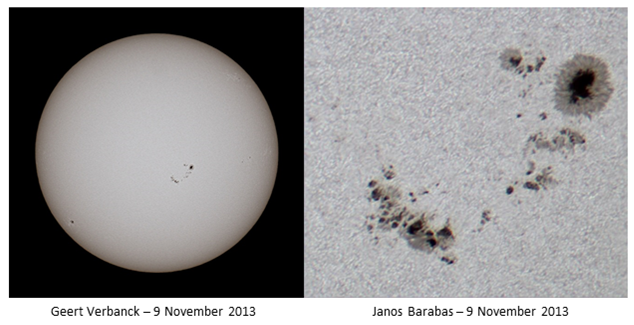
All 3 flares occurred in the trailing section of NOAA 1890, which contained a strong delta structure (see this STCE Newsletter at http://www.stce.be/news/222/welcome.html for more information). The SDO/AIA 1700 images underneath provide an idea of the location of each flare. The three flares were very short-lived, each lasting 10 minutes or less. In this movie at http://www.youtube.com/watch?v=1b1wFjkTslo , the short-duration flares are seen as very brief light flashes in the trailing sunspots of NOAA 1890.

The image underneath provides another view on these flares. It is actually a combination image showing the X1.1 flare from 8 November as seen in extreme ultra-violet light (SDO/AIA 171) overlaid on a white light picture of the source sunspot group (SDO/HMI). Otherwise said, it combines a picture of the flare seen in the corona with a picture of the sunspot group seen in the photosphere (solar surface).
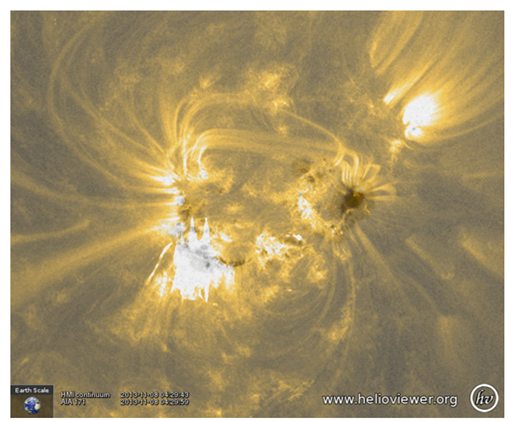
Though impulsive flares usually are not associated to coronal mass ejections (CMEs), these three flares seem to mark an exception. Most of the CMEs were directed southward, and no strong geomagnetic disturbance has been observed or is expected.
So far, there have been only 26 X-class flares during this solar cycle (SC24), 11 of which were produced this year. As can be seen in table underneath, the X3.3 flare was the third strongest of SC24. Nonetheless, this solar cycle has been lacking so far in truly strong flares (X10 or stronger). As this cycle maximum continues, more and potentially stronger flare events can be expected.
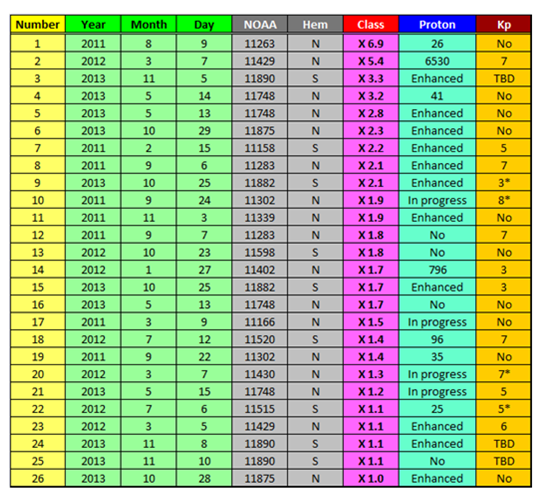
Credits - Data and imagery for the movie clips were taken from SDO (http://sdo.gsfc.nasa.gov/data/) and SOHO/LASCO (http://sohowww.nascom.nasa.gov/).
Thirteen active regions were reported by NOAA (Catania number in brackets): 1882 (23), 1884 (29), 1885 (28), 1887 (30), 1888 (26), 1889 (31), 1890 (35), 1891 (32), 1892 (37), 1893 (38), 1894 (34), 1895 (no Catania number), and 1896 (no Catania number). In addition, two sunspot groups reported by Catania (33 and 36) were short-lived and not reported as active regions by NOAA. The NOAA AR 1890 (Catania number 35) produced the most of the flaring activity, with three X-class flares (an X3.3 and two X1.1 flares), five M-class flares, and numerous C-class flares. One more M-class flare (M1.8) originated in the NOAA AR 1882 (Catania number 23) that was situated behind the west solar limb at that moment, and one more M-class flare (M2.3) flare was produced by the NOAA AR 1891 (Catania number 32). The strongest flare of the week was the X3.3 flare peaking at 22:12 UT on November 5 in the NOAA AR 1890 (Catania sunspot group 35).

Eight halo CMEs were detected during the week by SOHO/LASCO. A full halo CME appeared in the LASCO C2 field of view at 05:12 on November 4. The inspection of the STEREO/SECCHI data indicates that the CME source region was situated on the far side of the Sun (around N00W180 i.e. 90 degrees behind the west solar limb).
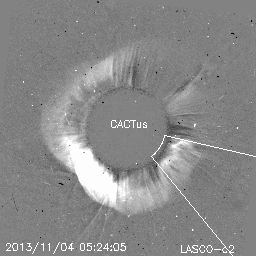
A partial halo CME (angular width around 180 degrees) first appeared in the LASCO C2 field of view at 08:24 UT on November 5. It propagated at the plane-of-the-sky projected speed of around 800 km/s and was associated with the M2.5 flare peaking at 08:18 UT in the NOAA AR 1890 (Catania number 35). STEREO/COR2 and SOHO/LASCO data clearly showed that the bulk of the material was ejected southward of the ecliptic plane, so the corresponding interplanetary disturbance did not arrive at the Earth.
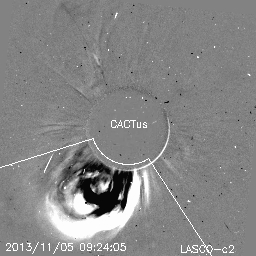
The CME associated with the X3.3 flare was a partial halo CME (angular width around 150 degrees) first appearing in the LASCO C2 field of view at 22:12 UT on November 5. It propagated at the average plane-of-the-sky speed of around 650 km/s. The bulk of the CME material was propagating to the south of the ecliptic plane, so the corresponding interplanetary disturbance did not arrive at the Earth.
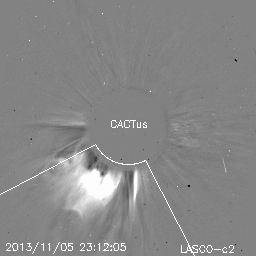
A partial halo CME was detected by SOHO/LASCO first appearing in the LASCO C2 field of view at 00:00 UT on November 7. The CME angular width was around 260 degrees and the plane-of-the-sky projected speed was around 1300 km/s. The CME was associated with the M1.8 flare peaking at 00:02 UT in the NOAA AR 1882 (Catania number 23) situated just behind the west solar limb. Due to the limb position of the CME source region, no clear signature of this event was detected in situ at 1 AU by ACE or SOHO/CELIAS. Check http://sidc.oma.be/cactus/catalog/LASCO/2_5_0/qkl/2013/11/CME0038/CME.html
Another halo CME on November 7 first appeared in the LASCO C2 field of view at 10:36 UT and had angular width of 360 degrees (full halo). The inspection of the SDO/AIA and STEREO/SECCHI data indicated that the CME source region was situated on the far side of the Sun (around N10E150 i.e. 60 degrees behind the east solar limb). The corresponding interplanetary disturbance did not arrive at the Earth. Check http://sidc.oma.be/cactus/catalog/LASCO/2_5_0/qkl/2013/11/CME0048/CME.html
SOHO/LASCO detected a full halo CME first appearing in the LASCO C2 field of view at 03:24 UT on November 8, propagating at the plane-of-the-sky projected speed of around 400 km/s. The CME was associated with the X1.1 flare in the NOAA AR 1890 (Catania sunspot group 35). The most of the CME mass was propagating southward of the ecliptic plane.
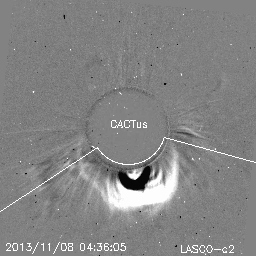
The X1.1 flare of November 10 was accompanied by a full halo CME first appearing in the SOHO/LASCO C2 field of view at 05:36 UT. The CME speed was around 800 km/s, and the bulk of the material was propagating southward of the ecliptic plane.
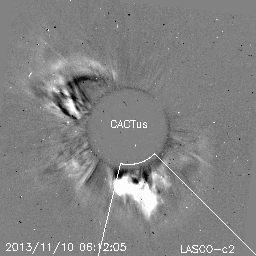
Another halo CME first appeared in the LASCO C2 field of view at 17:12 UT on November 10. It consisted of several fronts together constituting a full halo. No STEREO/COR2 information is available at the moment of writing to confirm the direction of the CME. SDO/AIA data show no EUV signatures of this CME in the low corona, so most probably this halo CME originates on the far side of the Sun. Check http://sidc.oma.be/cactus/catalog/LASCO/2_5_0/qkl/2013/11/CME0070/CME.html
The proton flux at energies above 10 MeV measured by GOES was above the usual background level (but still below the threshold of the proton event) during the whole week. On November 7 the proton flux strongly increased due to the first halo CME that was observed on that day (see above), without crossing the event threshold though. The background remained elevated even after this proton flux increase was over. This was most probably due to multiple eastern hemisphere eruptive events detected on the Sun.
In the beginning of the week the Earth was situated inside a slow solar wind flow. On November 7 an interplanetary sector boundary crossing was encountered, which resulted in one interval of active geomagnetic conditions (K = 4) as reported by Dourbes, IZMIRAN and NOAA.
In the picture below Phi is the angle in the ecliptic plane between the magnetic field (MF) and the line connecting the source point and the Sun. When Phi is 180 degrees, the MF is pointing away from the Sun. When Phi is 0 or 360 degrees, the MF points towards the Sun. When the solar wind is very fast, the MF lines are less bended: Phi = 0/360 or 180 degrees are associated with straight lines.
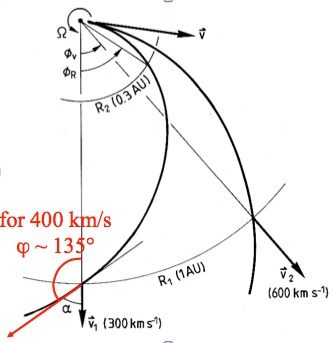
Different sectors are present in the ecliptic plane: sectors where the MF points inwards and sectors where the MF points outwards. When we pass from one sector to another, we call it a sector boundary crossing. In the graph below, Phi changes from values around 130 degrees to values around 270 degrees. Usually, the geomagnetic impact of a sector boundary crossing is limited.
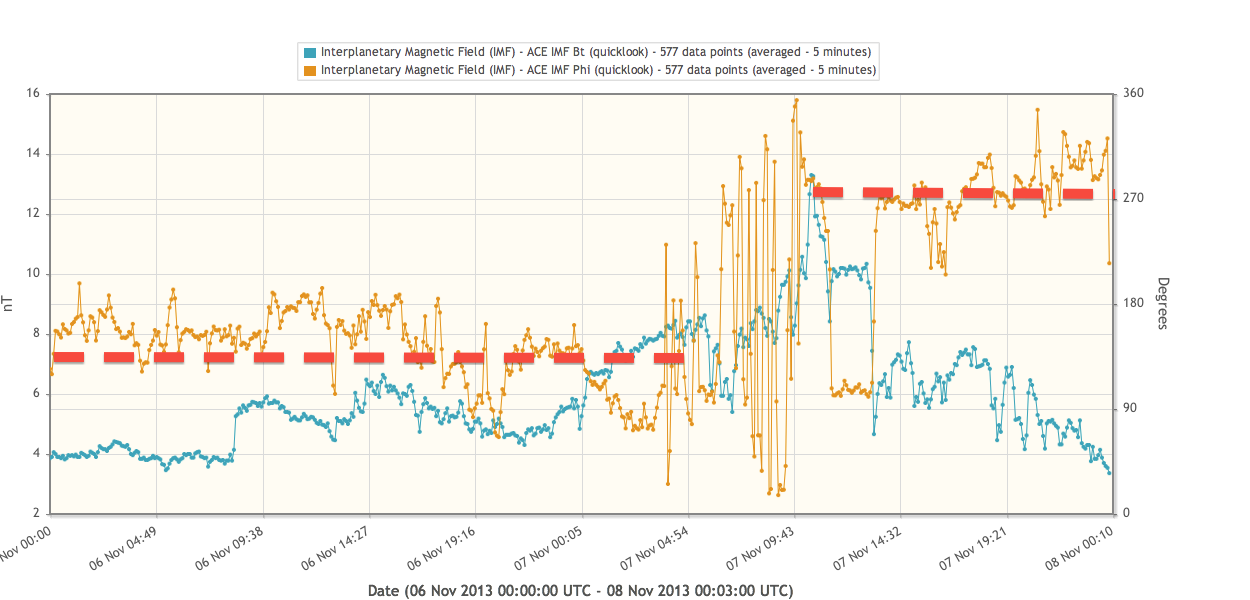
On November 9 the Earth entered a fast solar wind flow probably originating from a small equatorial coronal hole that passed the solar central meridian on November 7.
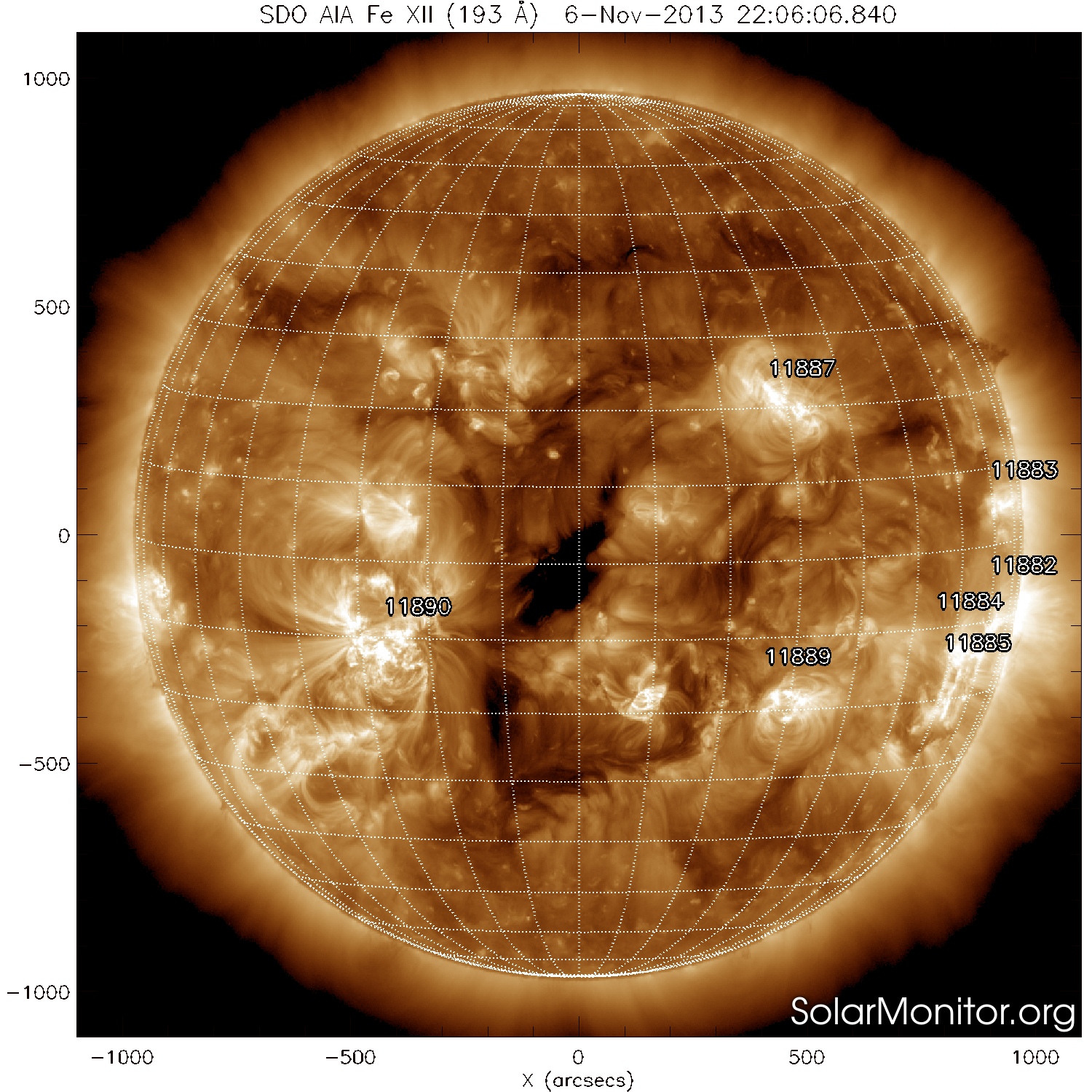
| DAY | BEGIN | MAX | END | LOC | XRAY | OP | 10CM | TYPE | Cat | NOAA |
| 05 | 0812 | 0818 | 0821 | S17E48 | M2.5 | 1F | 53 | 1890 | ||
| 05 | 1808 | 1813 | 1817 | M1.0 | 110 | III/2 | 1890 | |||
| 05 | 2207 | 2212 | 2215 | S12E46 | X3.3 | 1B | 400 | III/3V/3II/3IV/1 | 1890 | |
| 06 | 1339 | 1346 | 1353 | S12E37 | M3.8 | 1N | 190 | III/1II/2 | 1890 | |
| 06 | 2344 | 0002 | 0014 | M1.8 | ||||||
| 07 | 0334 | 0340 | 0343 | S14E28 | M2.3 | SN | III/2II/1 | 35 | 1890 | |
| 07 | 1415 | 1425 | 1431 | S13E23 | M2.4 | 1N | 170 | II/1III/2IV/1 | 35 | 1890 |
| 08 | 0420 | 0426 | 0429 | S14E15 | X1.1 | 2B | 1000 | III/3II/1IV/2 | 35 | 1890 |
| 08 | 0922 | 0928 | 0931 | S18W28 | M2.3 | 1B | 32 | 1891 | ||
| 10 | 0508 | 0514 | 0518 | S14W13 | X1.1 | 2B | 360 | III/3II/2IV/1 | 35 | 1890 |
| LOC: approximate heliographic location | TYPE: radio burst type |
| XRAY: X-ray flare class | Cat: Catania sunspot group number |
| OP: optical flare class | NOAA: NOAA active region number |
| 10CM: peak 10 cm radio flux |
Solar flare activity fluctuated between low and high during the week.
In order to view the activity of this week in more detail, we suggest to go to the following website from which all the daily (normal and difference) movies can be accessed: http://proba2.oma.be/ssa
This page also lists the recorded flaring events.
A weekly overview movie can be found here (SWAP week 189).
Details about some of this week's events, can be found further below.
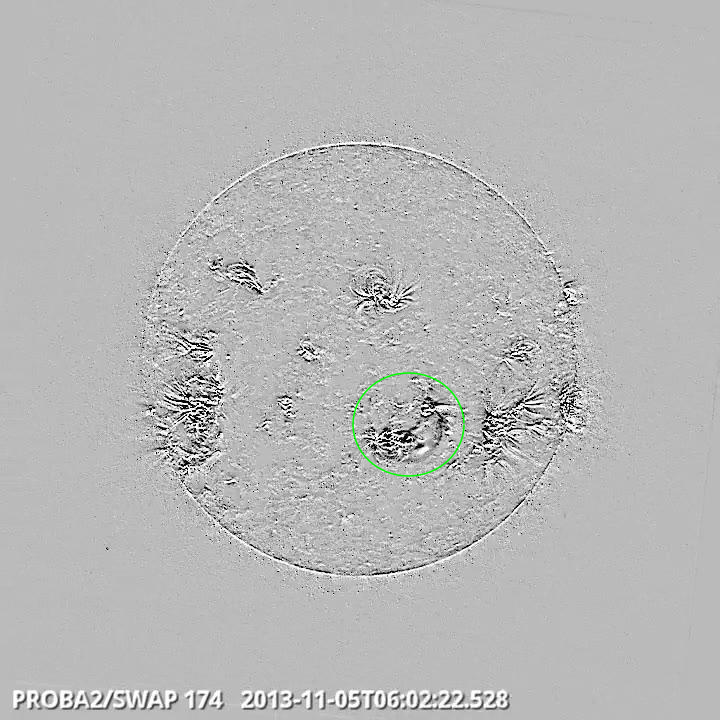
Eruption on south west quad @ 06:02 - SWAP difference image
Find a movie of the event here (SWAP difference movie)
http://proba2.oma.be/swap/data/mpg/movies/WeeklyReportMovies/WR189_Nov04_Nov10/Events/20131105_Eruption_SouthWestQuad_0602_swap_diff.mp4
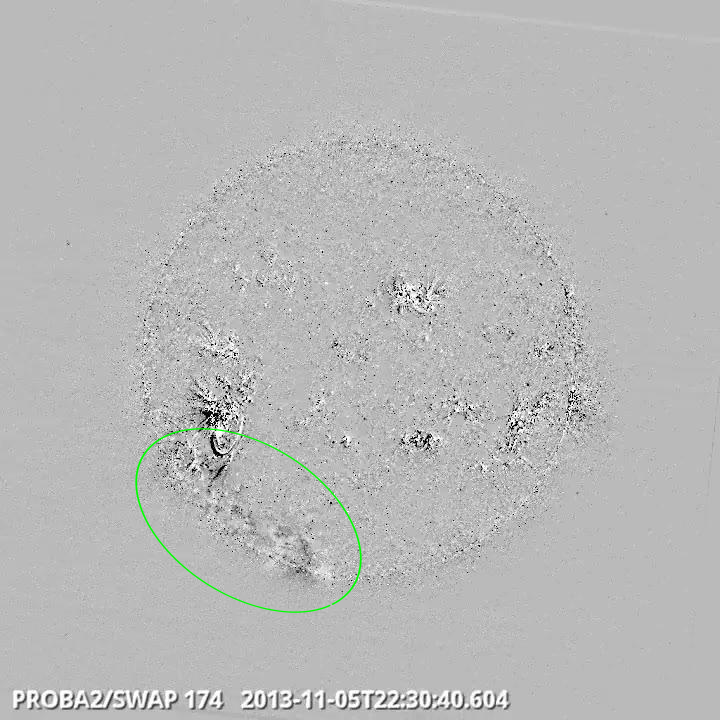
X-flare and EIT-wave on south east limb @ 22:30 - SWAP difference image
Find a movie of the event here (SWAP difference movie)
http://proba2.oma.be/swap/data/mpg/movies/WeeklyReportMovies/WR189_Nov04_Nov10/Events/20131105_EITwaveFollowingXflare_SouthEastLimb_2230_swap_diff.mp4
Find a movie of the event here (SWAP movie)
http://proba2.oma.be/swap/data/mpg/movies/WeeklyReportMovies/WR189_Nov04_Nov10/Events/20131105_EITwaveFollowingXflare_SouthEastLimb_2230_swap_movie.mp4
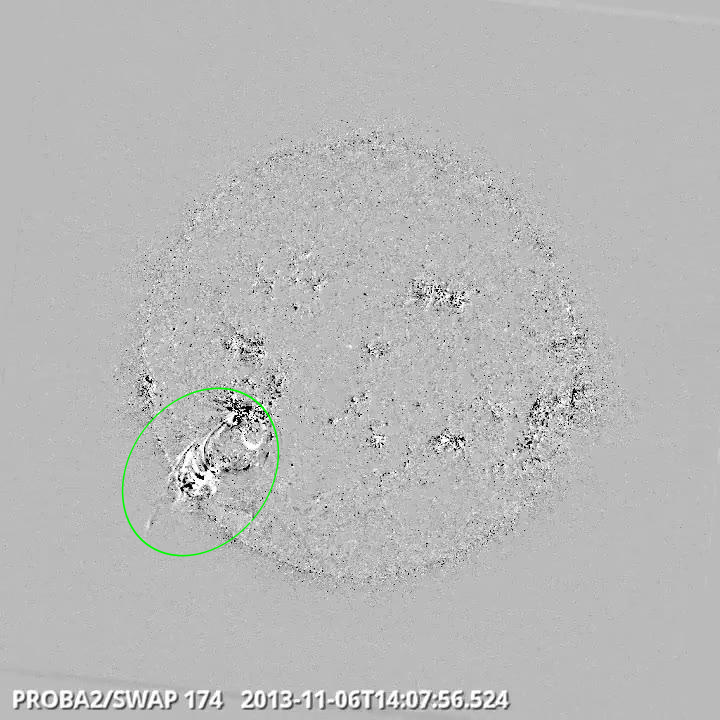
Eruption on south east quad @ 14:07 - SWAP difference image
Find a movie of the event here (SWAP difference movie)
http://proba2.oma.be/swap/data/mpg/movies/WeeklyReportMovies/WR189_Nov04_Nov10/Events/20131106_Eruption_SouthEastQuad_1407_swap_diff.mp4
Find a movie of the event here (SWAP movie)
http://proba2.oma.be/swap/data/mpg/movies/WeeklyReportMovies/WR189_Nov04_Nov10/Events/20131106_Eruption_SouthEastQuad_1407_swap_movie.mp4
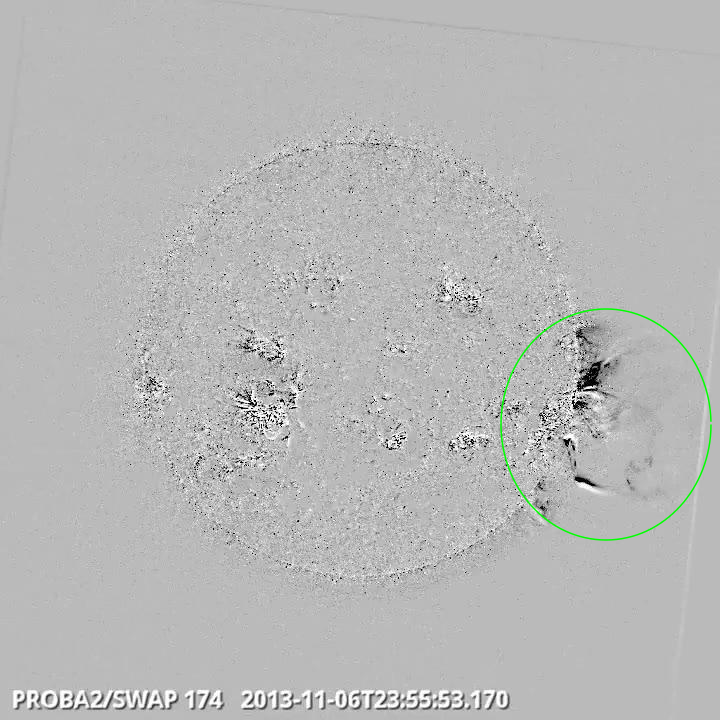
Eruption on west Limb @ 23:55 - SWAP difference image
Find a movie of the event here (SWAP difference movie)
http://proba2.oma.be/swap/data/mpg/movies/WeeklyReportMovies/WR189_Nov04_Nov10/Events/20131106_Eruption_WestLimb_2355_swap_diff.mp4
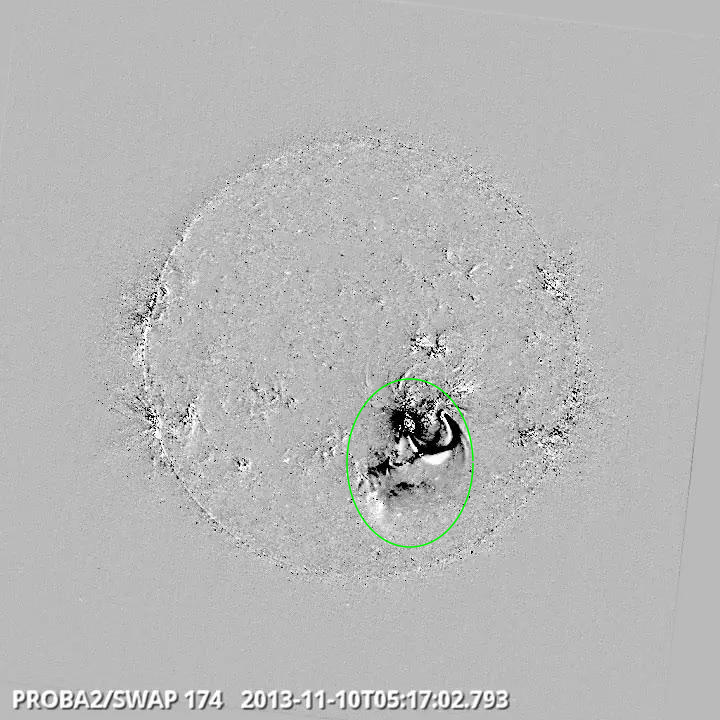
Eruption on south east quad @ 05:17 - SWAP difference image
Find a movie of the event here (SWAP difference movie)
http://proba2.oma.be/swap/data/mpg/movies/WeeklyReportMovies/WR189_Nov04_Nov10/Events/20131110_EruptionEITwave_SouthWestQuad_0517_swap_diff.mp4
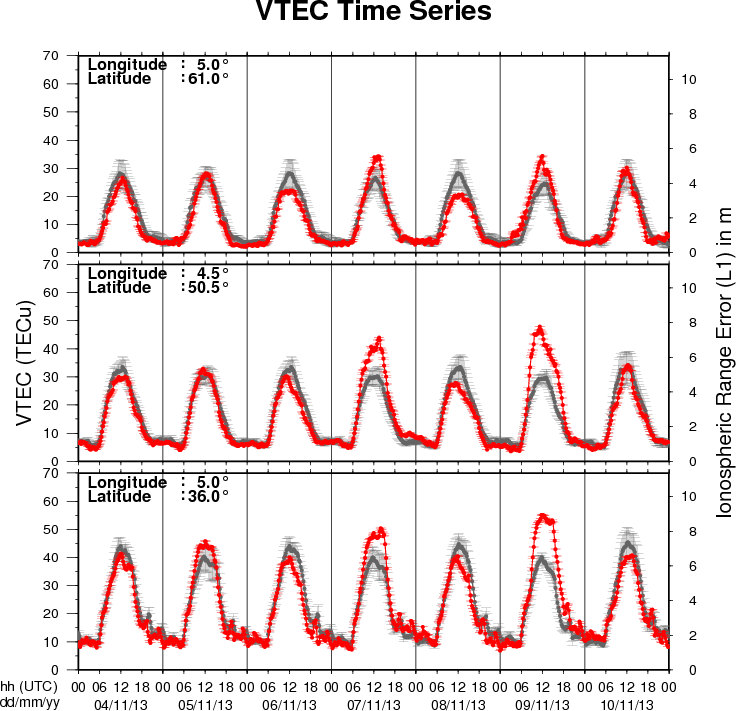
The figure shows the time evolution of the Vertical Total Electron Content (VTEC) (in red) during the last week at three locations:
a) in the northern part of Europe(N61°, 5°E)
b) above Brussels(N50.5°, 4.5°E)
c) in the southern part of Europe(N36°, 5°E)
This figure also shows (in grey) the normal ionospheric behaviour expected based on the median VTEC from the 15 previous days.
The VTEC is expressed in TECu (with TECu=10^16 electrons per square meter) and is directly related to the signal propagation delay due to the ionosphere (in figure: delay on GPS L1 frequency).
The Sun's radiation ionizes the Earth's upper atmosphere, the ionosphere, located from about 60km to 1000km above the Earth's surface.The ionization process in the ionosphere produces ions and free electrons. These electrons perturb the propagation of the GNSS (Global Navigation Satellite System) signals by inducing a so-called ionospheric delay.
See http://stce.be/newsletter/GNSS_final.pdf for some more explanations ; for detailed information, see http://gnss.be/ionosphere_tutorial.php
Start : 2013-11-18 - End : 2013-11-22
This International CAWSES-II Symposium hosted by SCOSTEP
(Scientific Committee on Solar-Terrestrial Physics) will provide an
excellent opportunity to discuss the scientific accomplishments of
CAWSES-II and look forward to SCOSTEP's future programs at a moment
toward the end of its five-year period. The symposium will cover
the six major themes of CAWSES-II tasks: 1) What are the solar
influences on the Earth's climate?, 2) How will geospace respond to
an altered climate?, 3) How does short-term solar variability
affect the geospace environment?, 4) What is the geospace response
to variable inputs from the lower atmosphere?, 5) Capacity
Building, 6) Informatics and eScience. The main functions of
CAWSES-II are to help coordinate international activities in
observations, modeling, and applications crucial to achieving this
understanding, to involve scientists in both developed and
developing countries, and to provide educational opportunities for
students of all levels. The symposium offers keynotes/lectures that
will be interesting for all participants every morning and more
specific sessions of presentations in the afternoon. We welcome all
those who are involved and/or interested in CAWSES-II to Nagoya in
the autumn when we will have the pleasure of being surrounded by
beautiful colorful leaves of this season.
Website:
http://www.cawses.org/CAWSES/leaflet_CAWSES-II_120229.pdf
Start : 2013-11-18 - End : 2013-11-22
The 10th Edition of the European Space Weather
Week will take place on 18-22nd
November 2013 in Belgium. The venue will be confirmed early next
year, but mark your calendars now for the 10th Anniversary of this
growing European event.
The ESWW will again adopt the central aim of bringing together
the diverse groups in Europe working on different aspects of Space
Weather
. This includes but isn't
limited to the scientific community, the engineering community,
applications developers, service providers and service end users.
The meeting organisation will again be coordinated by the Belgian
Solar-Terrestrial Centre of Excellence (STCE), ESA
and the Space Weather
Working Team. The local
organisation will be done by the STCE.
Website:
http://www.stce.be/esww10/
Start : 2013-11-26 - End : 2013-11-28
The 1st SPRING (Solar Physics Research Integrated Network Group)
workshop is being held from November 26 - 28, 2013 at the scenic
Brugger's Hotel Park by Titisee hosted by the Kiepenheuer-Institut
für Sonnenphysik in Freiburg, Germany.
The purpose of the workshop is to work on the scientific
requirements for a new ground-based network of telescopes for
full-disk synoptic observations of the Sun.
The desire for such a new network is motivated by new scientific
research directions in solar physics, the requirement of real-time
context data for high-resolution solar telescopes, and the need of
continuous, long-term, consistent, and reliable solar data as
foundation for space weather prediction.
Website:
http://www3.kis.uni-freiburg.de/~mroth/spring.html
Start : 2013-12-13 - End : 2013-12-13
The inclusion of space weather in the National Risk Assessment
in 2012 means that there is now an urgent need for dialogue between
those doing the science of space weather and those using the data
to forecast, understand and mitigate the risks.
Since the Sun is currently at the peak of its cycle - a time
when space weather events become more frequent - we have a timely
opportunity to study how a range of solar activity ultimately lead
to magnetospheric, ionospheric and ground level disturbances.
The goal of this meeting is to bring together those working
across the broad range of space weather activities in the UK to
discuss the current status of observations and recent new advances
in the theories and models of the phenomena of space weather.
Website:
http://www.mssl.ucl.ac.uk/~lmg/spaceweather/Overview.html
Start : 2013-12-16 - End : 2013-12-20
Scientific sessions:
Website:
http://tesis.lebedev.ru/workshop2013.html
Start : 2014-01-28 - End : 2014-01-31
We are pleased to announce the 2014 SORCE Science Meeting,
motivated by the NASA/EOS Solar Radiation and Climate Experiment
(SORCE). The agenda for this interactive meeting consists of
invited and contributed oral and poster presentations concerning
variations in the Sun's radiation and in the Earth environment. We
encourage your participation and hope that you will share this
announcement with colleagues.
Website:
http://lasp.colorado.edu/home/sorce/news-events/meetings/2014-sorce-science-meeting/
Start : 2014-02-10 - End : 2014-02-11
The International Space Weather Initiative (ISWI), with the
support of the United Nations Committee for the Peaceful Uses of
Outer Space, has been very active in promoting the installation of
new ground-based instrumentation in non-traditional locations. In
particular, there has been substantial progress in the observation
of the equatorial ionosphere, solar transients, and energetic
particles from space. In the coming decade these observations will
become available in real time and will be an important new data
source for the forecasting of space weather events. New instruments
are either in the process of deployment, or planned over the next
decade. Similarly, the International Living with a Star (ILWS)
program has been very active coordinating the plans of the world's
space agencies in the planning of new space missions, and in the
development of space weather modeling and forecasting.
Website:
http://newserver.stil.bas.bg/ISWI/Meetings/Cevents.html#item12
Start : 2014-03-16 - End : 2014-03-22
The meeting brings together scientists working in solar physics,
space physics, plasma physics, and astrophysics, in theory,
simulations, and experiment. The objective is to report and discuss
recent progress in our understanding of the fundamental processes
in solar, space, and astrophysical plasmas, in view of heliospheric
in-situ and remote sensing measurements (Van Allen Probe, Themis,
Cluster, Stereo, SDO, Messenger, Cassini, Venus-Express) and remote
sensing astrophysical observations (Chandra, XMM-Newton, Swift and
Fermi Gamma-ray Telescope).
Website:
http://physics.bgu.ac.il/~gedalin/Isradynamics2014/
Start : 2014-06-23 - End : 2014-06-27
The meeting in honour of Prof. Zdenek Svestka will cover issues
of the physics of solar and stellar flares.
Website:
http://solarflares2014.cz/
Start : 2014-08-02 - End : 2014-08-10
The 40th COSPAR Scientific Assembly will be held in Moscow,
Russia from 2 - 10 August 2014. This Assembly is open to all bona
fide scientists.
Website:
http://www.cospar-assembly.org/
Start : 2014-08-31 - End : 2014-09-05
Low-frequency waves (ULF, ELF and VLF) in space plasmas have
been studied for many decades. In our solar system, such waves
occur in the magnetospheres of planets and in the solar wind; more
recently they have also been confirmed on the Sun. In spite of the
great differences in the plasma properties of these regions, the
overarching schemes are wave generation, wave propagation, and wave
dissipation, which are three fundamental aspects of any kind of
waves. A fourth aspect of these waves is their application, either
with direct benefit to humans or for scientific pursuit. Therefore,
this Chapman conference will provide a forum in which various wave
communities can come together and discuss recent achievements of
observational, theoretical, and modeling studies.
Website:
http://chapman.agu.org/spaceplasmas/
Start : 2014-09-08 - End : 2014-09-12
The European Solar Physics Meetings aim to highlight all aspects
of modern solar physics, including observation and theory that span
from the interior of the Sun out into the wider heliosphere. These
meetings provide a broad, yet stimulating, environment for European
and international scientists to share their research in solar
physics.
The meeting will mostly comprise of contributed talks and poster
presentations, with several invited review talks (typically one per
session). Posters will be on display for the whole meeting in close
proximity to the lecture theatre. Refreshments will be served in
the poster viewing area during two dedicated coffee/poster breaks
on each full day.
Website: http://www.espm14.ie/
Start : 2015-06-22 - End : 2015-06-26
The Fourteenth International Solar Wind Conference will be held
for the first time ever in China, from 22 to 26 June 2015, at
Weihai in the Shandong province. It will be jointly organized by
the School of Earth and Space Sciences of Peking University and the
newly-established Institute of Space Sciences of Shandong
University. The meeting will take place in the Space Science
Building of Shandong University, a venue located within walking
distance to the beautiful Weihai International Bathing Beach, one
of the most popular scenic areas of northern China.
The conference will cover all aspects of solar wind physics,
with invited reviews and contributed papers that examine the
current research and outline the future research in all the
relevant solar wind fields.
Website: not available yet